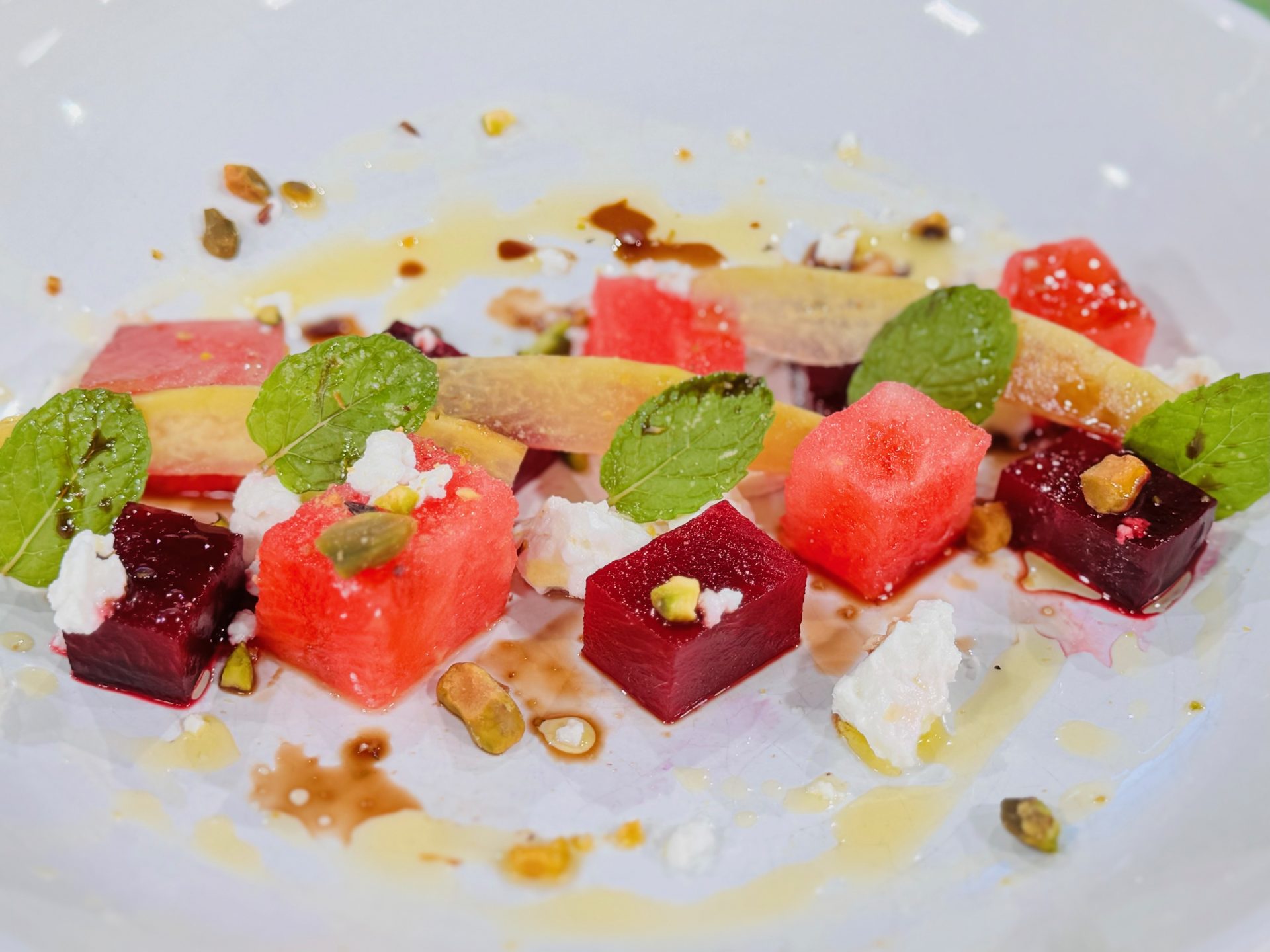A Flavorful, Sustainable Twist—Proudly Grown in Florida
If you’ve been with me for a while, you know I believe in using every last bit of what we bring into our kitchens. In my article “Buy the Whole Damn Watermelon”, I shared how one melon can give you juice, salad, dessert, and so much more—if you know how to work with it. Today, we’re taking that philosophy to the next level with a recipe that surprises and delights: No-Waste Watermelon Rind Pepperoncini.
🍉 From Farm to Ferment
This recipe is made possible thanks to my proud partnerships with Fresh From Florida, Melon1, Florida Fruit & Vegetable Association, and Better Seed. Because when you start with Florida-grown produce—ripe with sunshine, rich in flavor, and cultivated by farmers who care—you don’t waste a single bite.
So let’s talk about that rind.
Most people toss it. But not here. Watermelon rind is crisp, slightly sweet, and perfect for pickling. And when you turn it into a pepperoncini-style ferment? You’ve got a tangy, spicy, Southern-meets-Caribbean condiment that lights up everything from sandwiches and grain bowls to grilled meats and salads.
🌱 Why No-Waste Matters
Cooking isn’t just about what we serve—it’s about how we honor the land and the hands that feed us. Working with organizations like Fresh From Florida and Melon1 reinforces the beauty and responsibility of supporting Florida-grown produce and making the most of what we have.
And let’s be honest—the best cooking comes from the kitchens of resourceful women, like my mother, who always found a way to make more with less. This recipe is my modern ode to that tradition.
✨ Pro Tip:
Serve your watermelon rind pepperoncini on avocado toast, as a garnish for roast pork, or stirred into a creamy potato salad. It brings the acid, crunch, and character your summer meals crave.
We independently select all products we feature on Domestic Gourmet. I may earn an affiliate commission when you buy through links on this site.
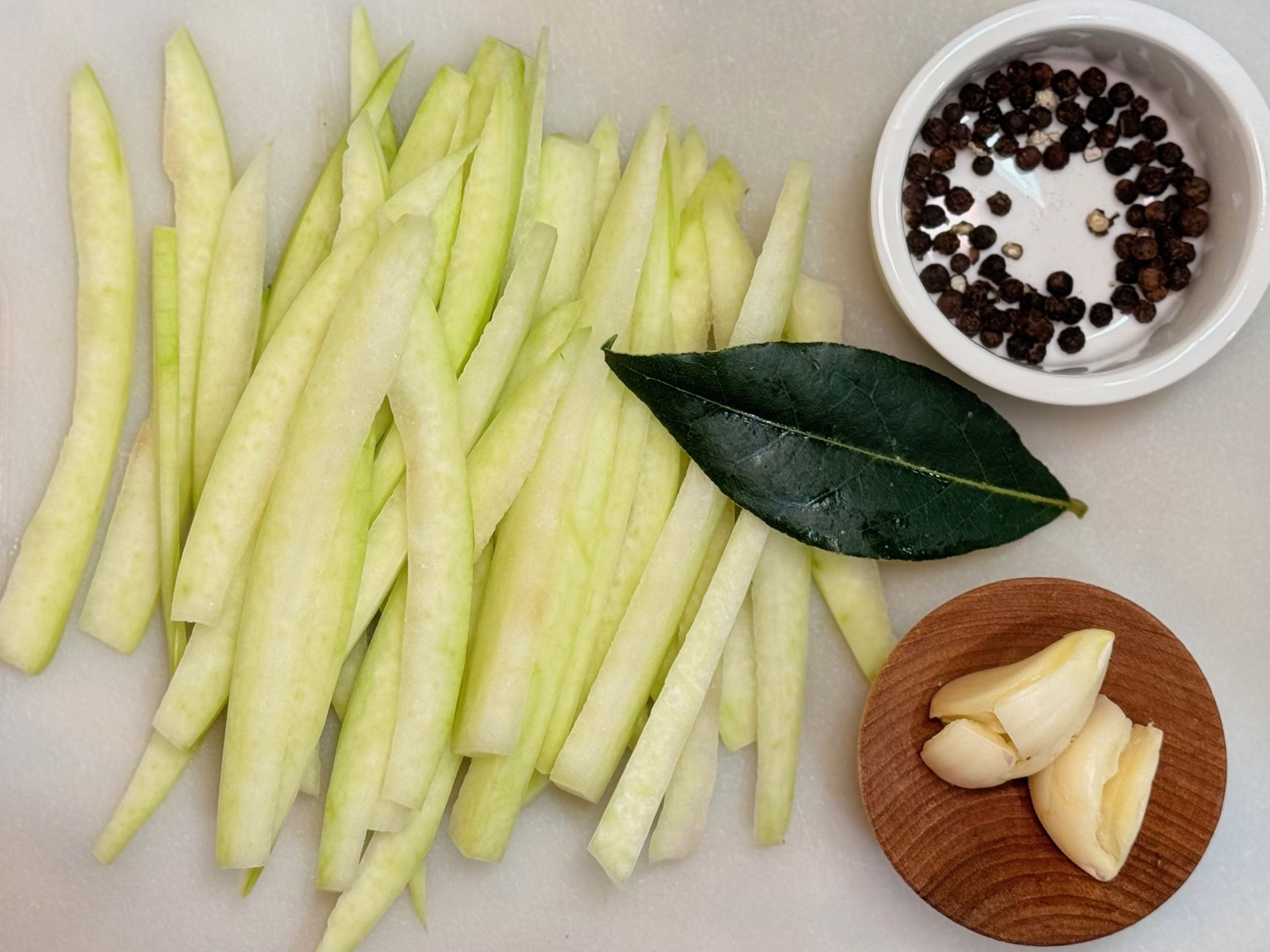
Watermelon Rind “Pepperoncini”
Equipment
- Optional: Water Bath Canner
Ingredients
- 3 cups sliced watermelon rind dark green skin and pink watermelon fruit removed
- 3 tsp black whole peppercorns for extra spice, crush 1 tsp or more
- 4 peeled and smashed garlic cloves
- 2 bay leaves
- 1 cup white vinegar
- 1 cup water
- 1 tbsp pickling salt can substitute with fine table salt
- 1 tbsp sugar
Instructions
- Bring the vinegar, water, salt, and sugar to a boil in a small saucepan, whisking to combine. The mixture should be a clear liquid. You should not be able to see the sugar or salt.
- Using a vegetable peeler, remove the dark green outer skin of the watermelon.
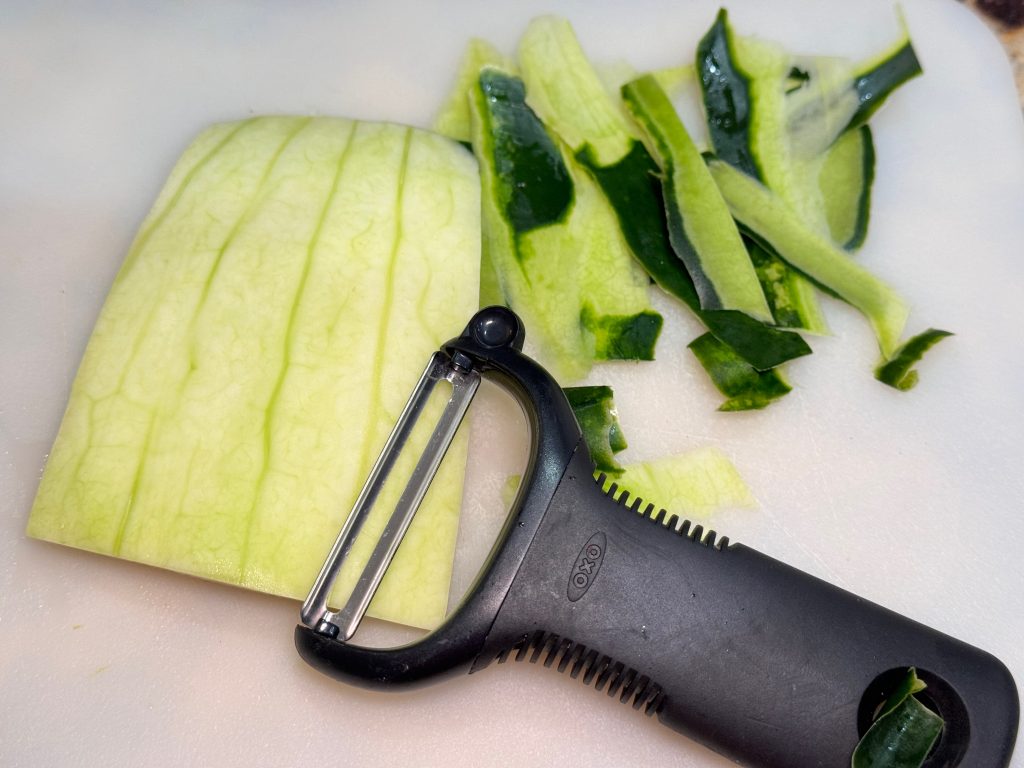
- Using a chef's knife, remove any remaining pink fruit from the underbelly of the watermelon rind.
- Slice the watermelon rind in ⅛" width and no longer than 4-5" in length. You want them to be shorter than the canning jar you're using to store them in.
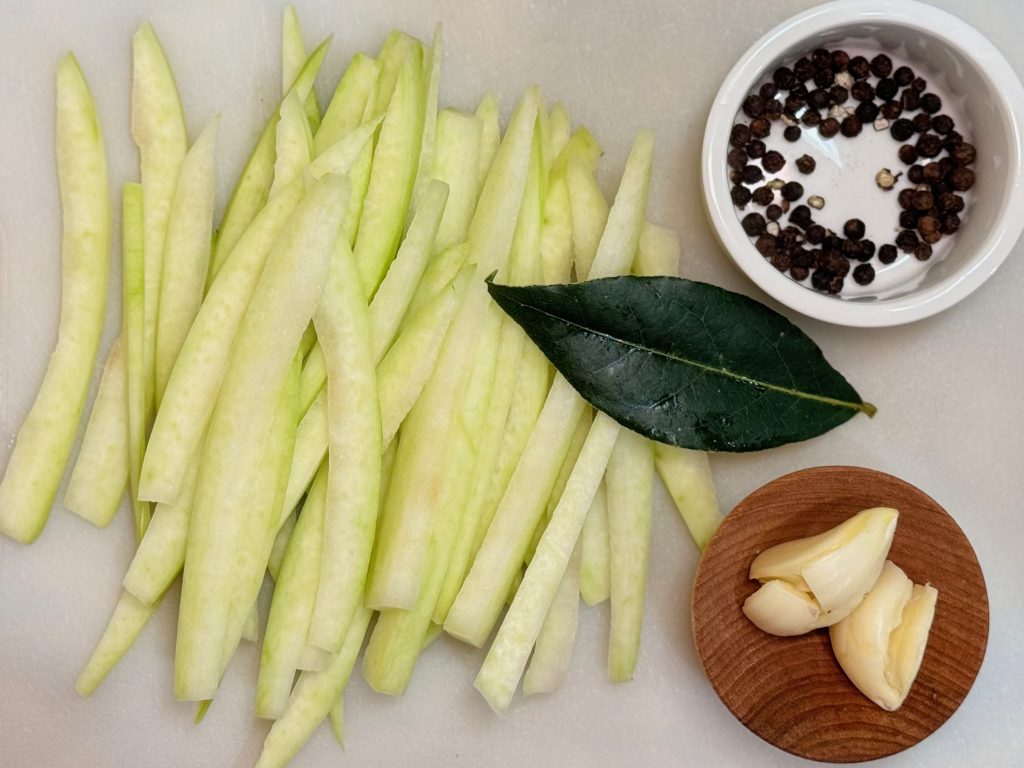
- Peel and smash the garlic cloves.
- Measure the peppercorns, smashing some for additional spice, or leave whole.
- Add two cloves of garlic and 1½ tsp black peppercorns to each jar. Fill the jar with the watermelon rind spears, standing them vertically, making sure not to over-stuff the jar. You want to ensure the pickling liquid can surround each rind to preserve them properly.
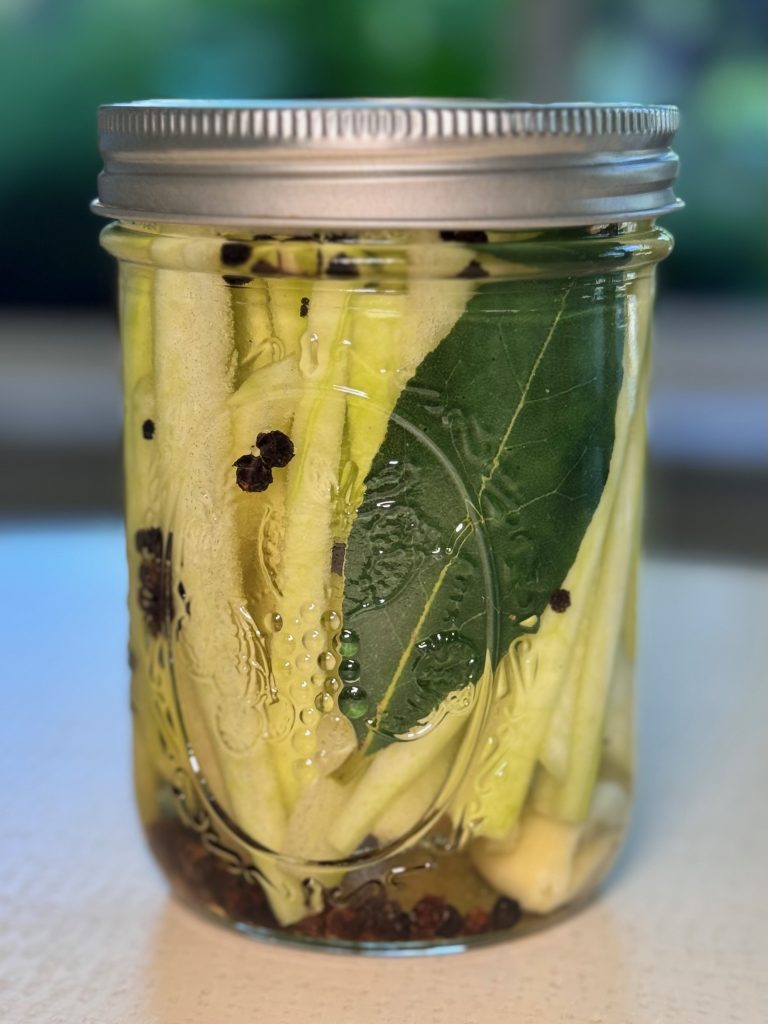
- Add 1 bay leaf to each jar and pour the hot pickling liquid over the contents, leaving ¼" of space at the top.
Pro Tip:
- This recipe can be easily multiplied or divided.
- Store in the refrigerator for up to two weeks.
- Proper water bath canning methods must be used to store for up to 1 year. (see below for instructions)
Canning Method:
- Place the jars into the canner, making sure that the jars are covered by at least 1 inch of water. Cover your pot with the lid and bring to a boil, boiling for 10 minutes.
- Turn off the heat, remove the lid, and let sit for 5 minutes.
- Remove the jars from the canner and set them on a towel to seal. Let them sit on your counter on top of a towel until they have reached room temperature. You can repeat the canning process if the jars have not been sealed after 12 hours. You'll know when the jars have suctioned by either hearing a loud "snap!" or seeing the indentation on the lid. Once properly sealed, this is shelf-stable for 1 year.
Notes
Nutrition
Ready to Get Pickling?
Don’t toss that rind—transform it.
And when you do, tag @DomesticGourmet on Instagram, and hashtag #domesticgourmet. and show me how you’re giving new life to this humble, often-overlooked part of one of Florida’s sweetest treasures.
About the Author: Ciji Castro
Ciji Castro is the CEO and Executive Chef behind Domestic Gourmet, a premium food and lifestyle brand rooted in honoring ancestral cooking and Latin traditions. With a deep love for bold, heritage-inspired flavors and clean ingredients, Ciji leads the vision and culinary direction of Domestic Gourmet’s product line.
Her flagship product, 🌿 Domestic Gourmet Organic Annatto Oil – Aceite de Achiote, brings vibrant color and flavor to every dish—celebrating the flavors of her Cuban and Puerto Rican roots while meeting the standards of today’s health-conscious kitchens.
Through Domestic Gourmet, Ciji is on a mission to share the richness of cultural cooking with a modern and convenient twist—one thoughtfully crafted product at a time.
Follow along at @domesticgourmet for recipes, cooking tips, and more.

